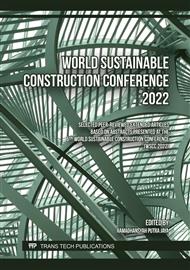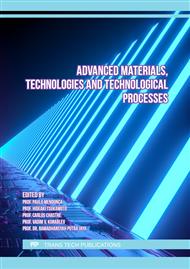[1]
R. P. Singh, S. Nimbalkar, S. Singh, and D. Choudhury, "Field assessment of railway ballast degradation and mitigation using geotextile," Geotextiles and Geomembranes, vol. 48, no. 3, p.275–283, 2020.
DOI: 10.1016/j.geotexmem.2019.11.013
Google Scholar
[2]
P. K. Chamling, S. Haldar, and S. Patra, "Physico-Chemical and mechanical characterization of steel slag as railway ballast," Indian Geotechnical Journal, vol. 50, no. 2, p.267–275, 2020.
DOI: 10.1007/s40098-020-00421-7
Google Scholar
[3]
T. Koh, S.-W. Moon, H. Jung, Y. Jeong, and S. Pyo, "A feasibility study on the application of Basic Oxygen Furnace (BOF) steel slag for railway ballast material," Sustainability, vol. 10, no. 2, p.284, 2018.
DOI: 10.3390/su10020284
Google Scholar
[4]
Y. Guo, V. Markine, W. Qiang, H. Zhang, and G. Jing, "Effects of crumb rubber size and percentage on degradation reduction of railway ballast," Construction and Building Materials, vol. 212, p.210–224, 2019.
DOI: 10.1016/j.conbuildmat.2019.03.315
Google Scholar
[5]
M. Sol-Sánchez, F. Moreno-Navarro, M. C. Rubio-Gámez, N. Manzo, and V. Fontseré, "Full-scale study of Neoballast section for its application in railway tracks: Optimization of Track Design," Materials and Structures, vol. 51, no. 2, 2018.
DOI: 10.1617/s11527-018-1167-2
Google Scholar
[6]
D. Youventharan, K. M. Jeevithan, O. Rokiah, and S. Mohd Arif, "Influences of waste inclusion on impact and crushing force resistance of track ballast," Key Engineering Materials, vol. 912, p.225–240, 2022.
DOI: 10.4028/p-o0c648
Google Scholar
[7]
D. Youventharan, P. J. Ramandhansyah, K. M. Jeevithan, O. Rokiah, S. Mohd Arif, and H. Yaacob, "Durability performance of concrete debris and bottom ash as an alternative track ballast material," IOP Conference Series: Earth and Environmental Science, vol. 682, no. 1, p.012053, 2021.
DOI: 10.1088/1755-1315/682/1/012053
Google Scholar
[8]
H. Boler, Y. Qian, and E. Tutumluer, "Influence of size and shape properties of railroad ballast on aggregate packing," Transportation Research Record: Journal of the Transportation Research Board, vol. 2448, no. 1, p.94–104, 2014.
DOI: 10.3141/2448-12
Google Scholar
[9]
Y. Guo, V. Markine, W. Qiang, H. Zhang, and G. Jing, "Effects of crumb rubber size and percentage on degradation reduction of railway ballast," Construction and Building Materials, vol. 212, p.210–224, 2019.
DOI: 10.1016/j.conbuildmat.2019.03.315
Google Scholar
[10]
Y. Sun, Particuology Breakage and shape analysis of ballast aggregates with different size distributions, 2017.
DOI: 10.1016/j.partic.2017.02.004
Google Scholar
[11]
M. Esmaeili, A. Shamohammadi, and S. Farsi, "Effect of deconstructed tire under sleeper pad on railway ballast degradation under cyclic loading," Soil Dynamics and Earthquake Engineering, vol. 136, p.106265, 2020.
DOI: 10.1016/j.soildyn.2020.106265
Google Scholar
[12]
B. Indraratna, C. Rujikiatkamjorn, M. Tawk, and A. Heitor, "Compaction, degradation and deformation characteristics of an energy absorbing matrix," Transportation Geotechnics, vol. 19, p.74–83, 2019.
DOI: 10.1016/j.trgeo.2019.02.002
Google Scholar
[13]
J. Yang, T. Ishikawa, T. Tokoro, T. Nakamura, I. Kijiya, and T. Okayasu, "Effect evaluation of drainage condition and water content on cyclic plastic deformation of aged ballast and its estimation models," Transportation Geotechnics, vol. 30, p.100606, 2021.
DOI: 10.1016/j.trgeo.2021.100606
Google Scholar
[14]
Y. Huang, J. Chen, S. Shi, B. Li, J. Mo, and Q. Tang, "Mechanical properties of municipal solid waste incinerator (MSWI) bottom ash as alternatives of subgrade materials," Advances in Civil Engineering, vol. 2020, p.1–11, 2020.
DOI: 10.1155/2020/9254516
Google Scholar
[15]
P. Anbazhagan, T. P. Bharatha, and G. Amarajeevi, "Study of ballast fouling in railway track formations," Indian Geotechnical Journal, vol. 42, no. 2, p.87–99, 2012.
DOI: 10.1007/s40098-012-0006-6
Google Scholar
[16]
Q. Gu, C. Zhao, X. Bian, J. P. Morrissey, and J. Y. Ooi, "Trackbed settlement and associated ballast degradation due to repeated train moving loads," Soil Dynamics and Earthquake Engineering, vol. 153, p.107109, 2022.
DOI: 10.1016/j.soildyn.2021.107109
Google Scholar
[17]
Z. Su, H. Huang and J. Guoqing, "Experimental analysis permeability characteristics of fouling railway ballast." Metallurgical and Mining Industry, vol. 7(9), p.986–991, 2015.
Google Scholar
[18]
P. Anbazhagan, T. P. Bharatha, and G. Amarajeevi, "Study of ballast fouling in railway track formations," Indian Geotechnical Journal, vol. 42, no. 2, p.87–99, 2012.
DOI: 10.1007/s40098-012-0006-6
Google Scholar
[19]
M. Koohmishi and M. Palassi, "Effect of gradation of aggregate and size of fouling materials on hydraulic conductivity of sand-fouled railway ballast," Construction and Building Materials, vol. 167, p.514–523, 2018.
DOI: 10.1016/j.conbuildmat.2018.02.040
Google Scholar
[20]
Antoni, K. Klarens, M. Indranata, L. Al Jamali, and D. Hardjito, "The use of bottom ash for replacing fine aggregate in concrete paving blocks," MATEC Web of Conferences, vol. 138, p.01005, 2017.
DOI: 10.1051/matecconf/201713801005
Google Scholar
[21]
J. M. Sadeghi, J. A. Zakeri, and M. E. Najar, "Developing track ballast characteristic guideline in order to evaluate its performance," International Journal of Railway, vol. 9, no. 2, p.27–35, 2016.
DOI: 10.7782/ijr.2016.9.2.027
Google Scholar
[22]
T. U. Ganiron, "Recycling concrete debris from construction and demolition waste," International Journal of Advanced Science and Technology, vol. 77, p.7–24, 2015.
DOI: 10.14257/ijast.2015.77.02
Google Scholar
[23]
S. Ghannam, "Recycling Destructed Concrete in Building Reconstruction," jeaconf, 2019. [Online]. Available: http://www.jeaconf.org/UploadedFiles/Document/c996f878-b158-447c-b3f7-d4b8ede0f9d5.pdf. [Accessed: 2019].
Google Scholar
[24]
J. J. Kumara and K. Hayano, "Deformation characteristics of fresh and fouled ballasts subjected to tamping maintenance," Soils and Foundations, vol. 56, no. 4, p.652–663, 2016.
DOI: 10.1016/j.sandf.2016.07.006
Google Scholar
[25]
J. Samuel Simron, M. M Vijayalakshmi, S. Lakshmi and R. Murugesan. "Effect of Flaky and Elongated Aggregates with Modified Compaction Technique using Superpave Gradation," Advances in Natural and Applied Sciences, vol. 10(14), 2016.
Google Scholar



